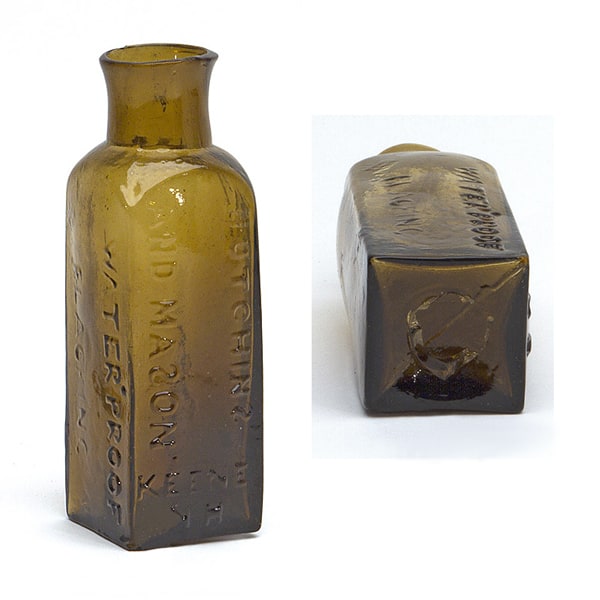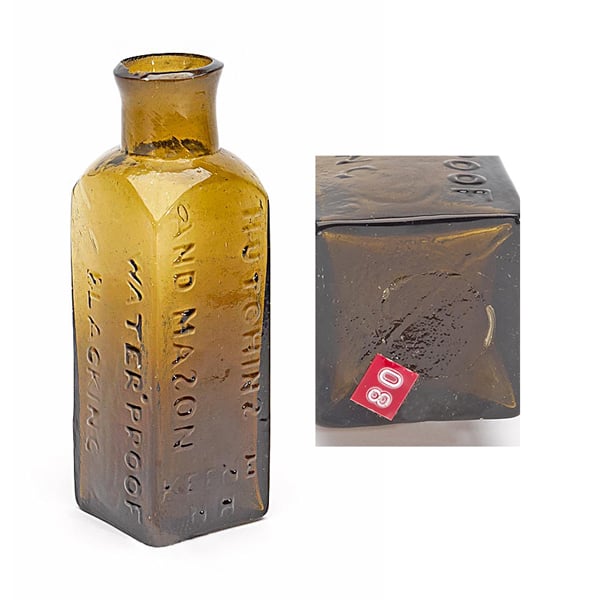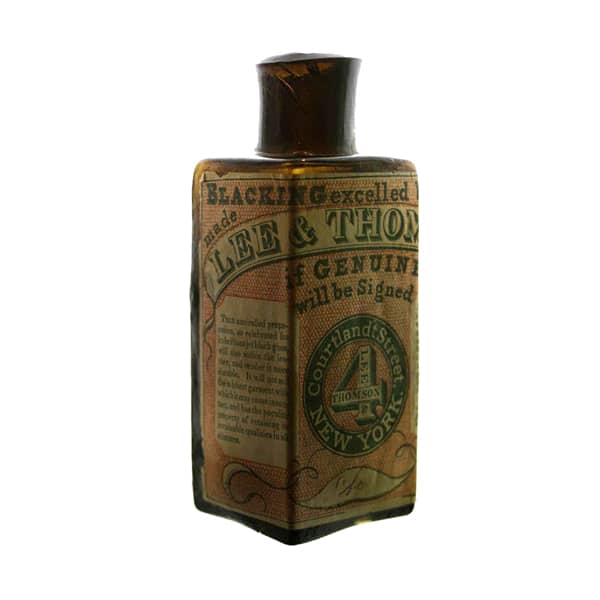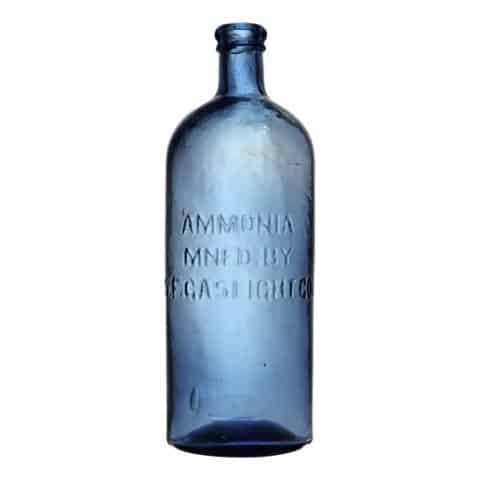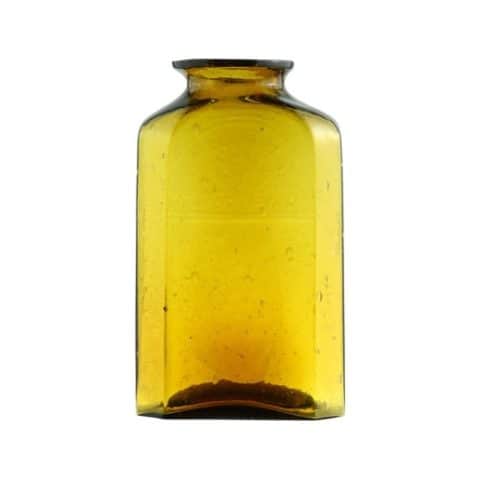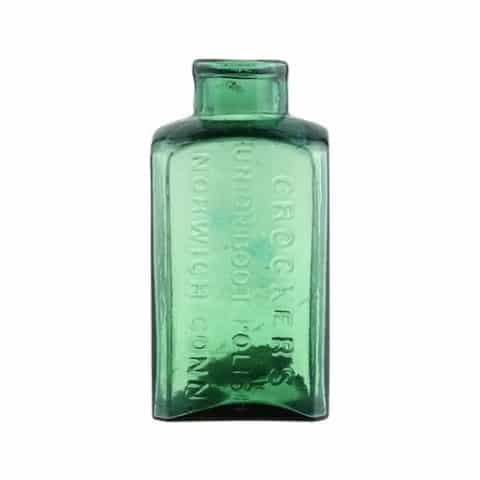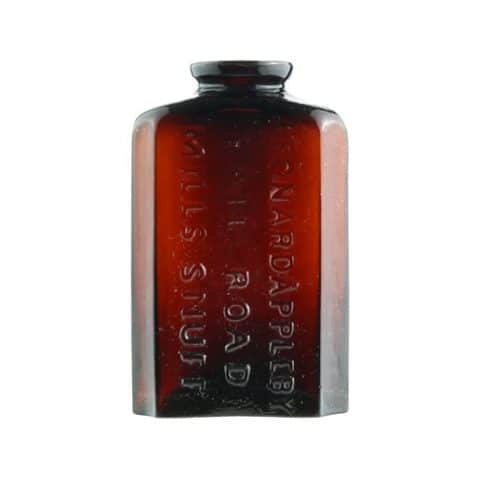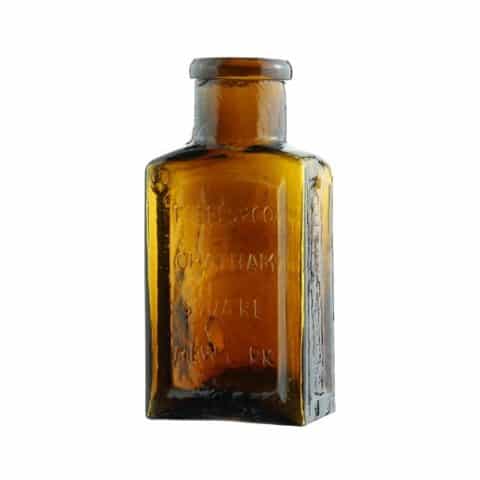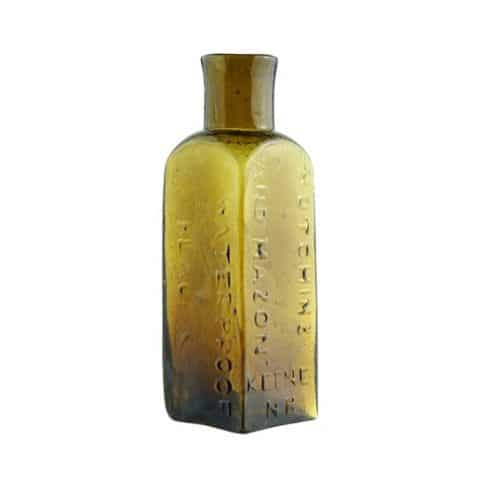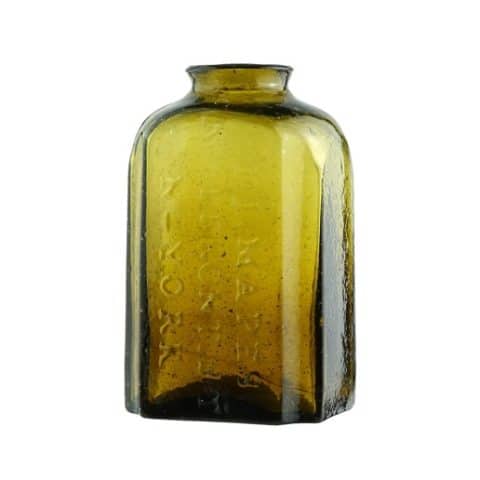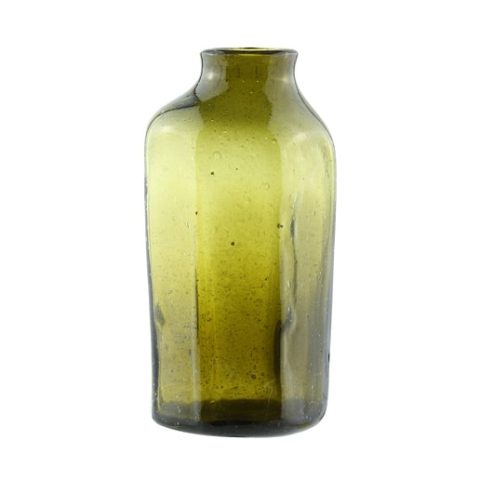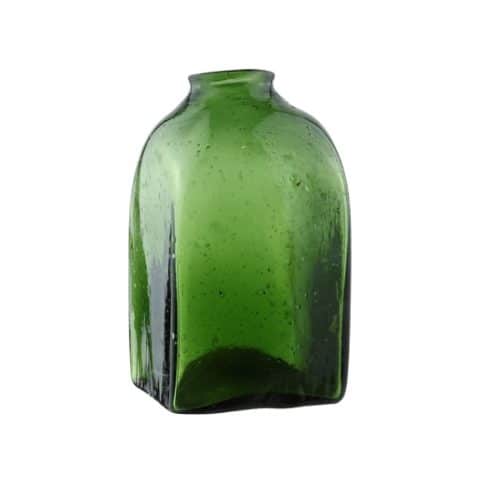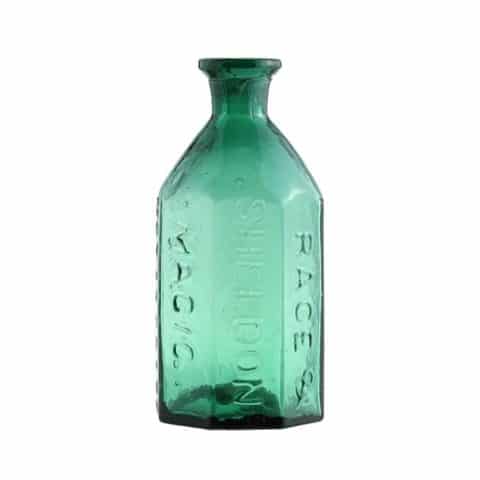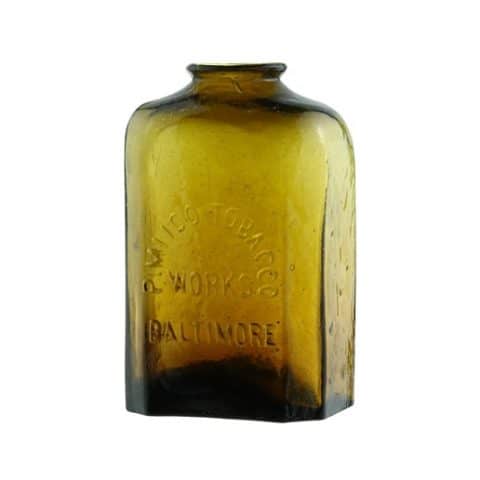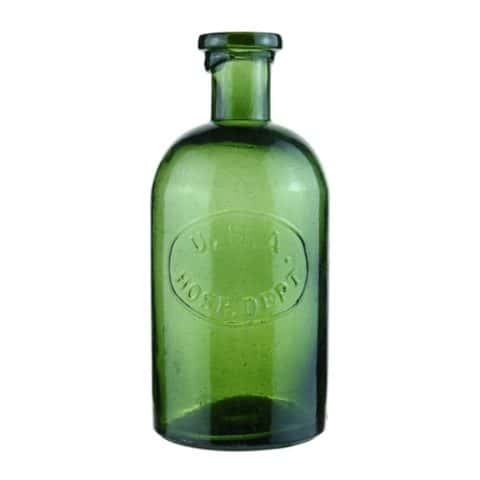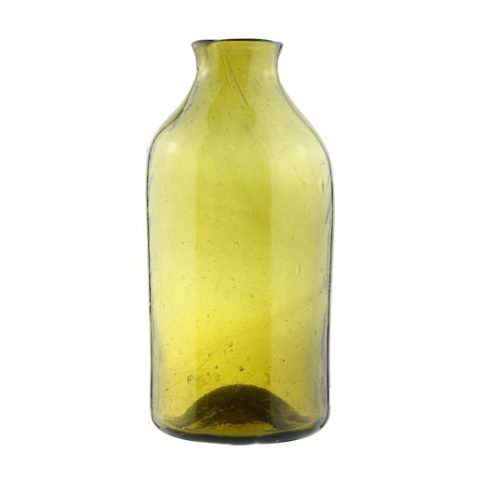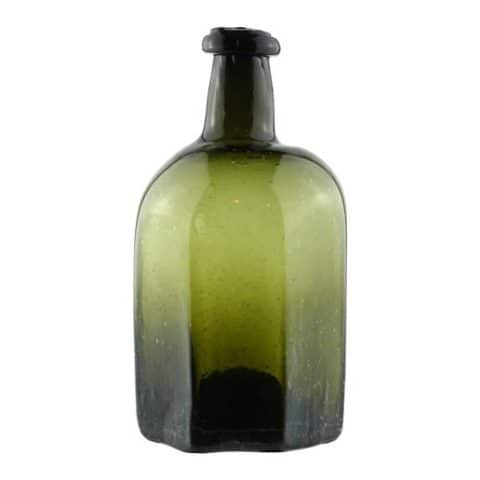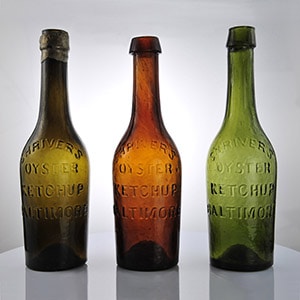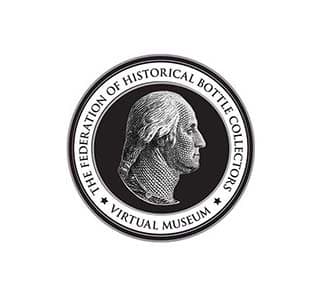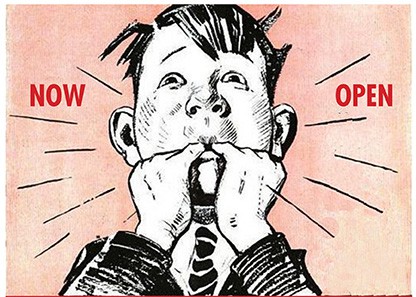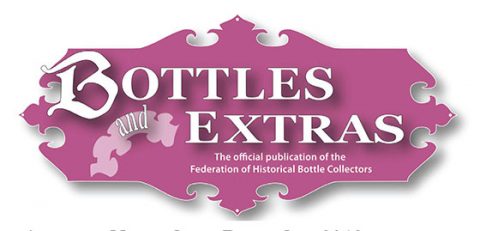Hutchins And Mason Keene NH Waterproof Blacking
Hutchins’ And Mason Keene NH
Water Proof Blacking
Attributed to David Hutchins and Andrew R. Mason, Keene, New Hampshire
Honey Amber Blacking Bottle
Provenance: Michael George Collection

Our museum example of a “Hutchins’ and Mason Keene NH Water Proof Blacking” bottle contained a product for enhancing the appearance of shoes and boots. Blacking was any preparation for producing a black coating or finish, as on shoes or stoves. It was usually a substance like a liquid polish or paste. With dirt roads, paths, mud, and rough sidewalks in the mid 19th century, you can only imagine how important waterproof blacking was to keep up your appearance.
This very rare 5-½” tall pontiled bottle was made in a square form and is embossed in a sans serif typestyle ‘HUTCHINS’ AND MASON’ vertically, shoulder to base, on one face of the bottle. On the same face, ‘KEENE N H’ is embossed in two horizontal lines beneath the above-mentioned copy and along the base. Both letter “S’s” are backward in “Hutchins” and “Mason.” On a second continuous side, ‘WATER PROOF BLACKING’ is embossed vertically, shoulder to base in a similar manner as the previous side. There is an embossed dot between “Water” and “Proof.” A paper label may have been placed on the two blank panel sides of the bottle. The side panels are arched at the shoulder with a flared neck terminating with a sheared mouth. This example was blown in a honey amber glass with an olive tone distinctive of a Stoddard, New Hampshire glasshouse.
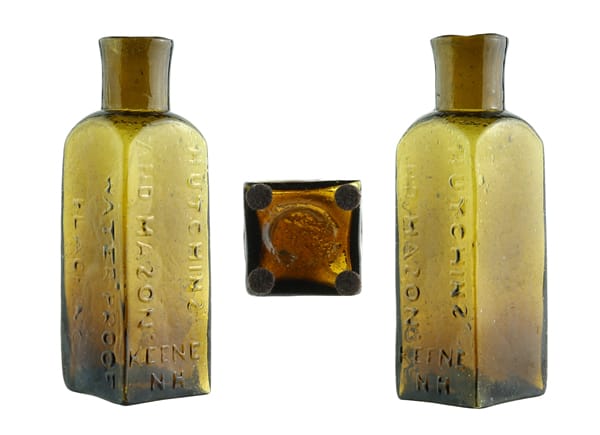
In the 1960s, a small group of these bottles and many glass shards was found in Creighton Hall’s Keene, New Hampshire side yard when he was setting a pole for a clothesline. Creighton was the president of the Yankee Bottle Club for many years and was the driving force behind the Yankee Bottle Clubs Keene Antique Bottle Show and Sale each October. At the time, the bottles were the only ones known and condition-wise had never been filled with content or used.
Creighton showed his wife Alene the first shard he found and she was intrigued enough to take over the yard excavation project. She continued with the hole and kept digging until she eventually found hundreds of pieces of glass and several complete bottles. After some research, the Hall’s discovered that the property next to theirs had once been the site of a cobbler’s shop with a structure that had long ago been torn down. They found out that the cobbler had intended to go into the shoe-polish business and ordered about 200 small bottles. He stored them empty in a small shed near his shop. The shed’s floor collapsed with the bottles ending up in the ground with many of them broken. His shoe-polish business never coming to fruition.
Read: For Keene native, antique glass is window into region’s past
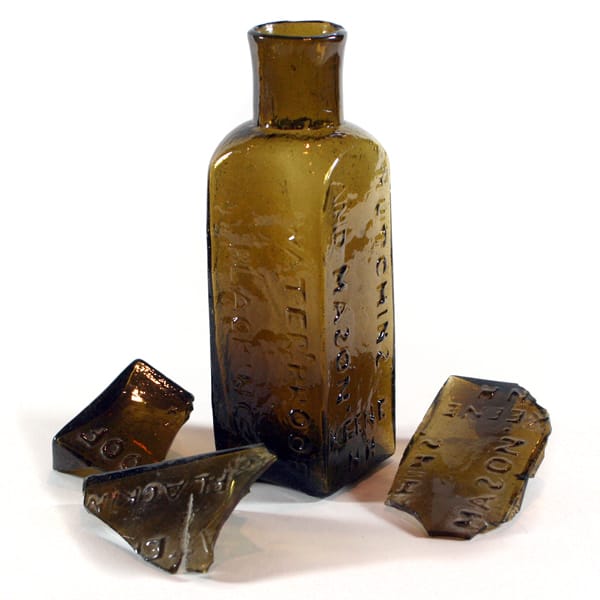
David Hutchins and Andrew R. Mason
Not much is known about Hutchins and Mason who had their last names embossed on the subject blacking bottle. We do know that David Hutchins was born on October 5, 1808, in Winchester, Cheshire County, New Hampshire, and was of Canadian ancestry. His father was Elisha Hutchins (1784-1859) and his mother, Sally Smith (1784-1864). David Hutchins’s brother William (1809–1856) was born on December 16, 1809, and his sister Elisha in 1812. David Hutchins would marry Rossa Black from Chesterfield, New Hampshire on June 12, 1833.
David Hutchins was a life-long shoemaker and dealer who lived and worked in Keene, New Hampshire. We see this as evidence each decade from 1840 to 1870 in United States Federal Census Reports. When reading about the early businesses in Keene we see the following passages of interest,
“Among the industries listed in the 1831 directory were a brickmaker, two pail makers, a potash manufacturer, a shingle maker, a carding mill, two glass factories, two chaise and sleigh makers, and two tanners.”
“By 1849 there were three apothecaries, a baker, a bonnet manufacturer and dealer, a bookbinder, a book jobber and printer, a bookseller and publisher, two boot and shoe manufacturers, a carriage maker, two Daguerrean artists, a dentist, two chair manufacturers, two-door, sash, and blind makers, a gunsmith, a hairdresser, two livery stables, three newspapers, an organ builder, a pail manufacturer, a sleigh manufacturer, two saddle, harness, and truck makers, two stove manufacturers, a woolen goods manufacturer, an insurance agent, three banks, a mortise, and tenoning machine company, a tannery, three restaurants, four hotels, two tin plate, and sheet ironworkers, and a number of stores. Mechanical power then in use came from rivers, brooks, and horses.”
Another passage just a few years later notes, “The principal shoe dealers and manufacturers were George Kingsbury, S. L. Randall, Geo. P. Drown, David Hutchins, O. P. Hall, and W. O. Willson.”
For a very brief period, Hutchins would partner with Andrew Robinson Mason who was a merchant in town. He was younger and was born in 1834 in New Hampshire. They would have a short run of bottles made at a Stoddard area glasshouse. The cobbler referenced further above probably ordered a batch of bottles for his short-lived business from Hutchins and Mason. David Hutchins would work hard throughout his life in the shoe and boot business and would die on September 24, 1878. He was quite wealthy and left his estate including land and buildings he owned in Keene to his wife Rossa. Andrew Mason would move into the hotel business the following years.
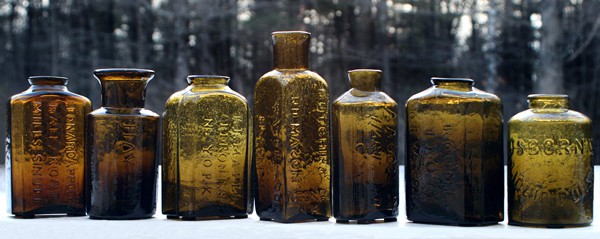
Primary Image: Hutchins and Mason Keene N H Water Proof Blacking bottle imaged on location by Alan DeMaison, FOHBC Virtual Museum Midwest Studio
Support Image: Auction Lot 70: “Hutchins’ / And Mason. / Keene / NH / Water.Proof / Blacking” Bottle, a Stoddard glasshouse, Stoddard, New Hampshire, 1846-1860. Square, bright olive amber, sheared mouth – pontil scar, ht. 5 5/8 inches; (two 3/16 inch chips from mouth edge). McK plate 227, #11 Extremely rare. Strong mold impression. Attractive color. – Norman Heckler Jr. & Sr., Norman C. Heckler & Company, Auction #133
Support Image: Auction Lot 41: “Hutchins’ / And Mason / Keene / NH / Water’ Proof / Blacking” Bottle, a Stoddard glasshouse, Stoddard, New Hampshire, 1846-1860. Square, yellow olive, sheared mouth – pontil scar, ht. 5 1/2 inches; (1/8 inch repaired hole in one base corner). “Keene And Stoddard Glass” by Lane & Pappas, 1970, plate 10 #2 Strongly embossed. Rare. Kris Kernozicky collection. – Norman Heckler Jr. & Sr., Norman C. Heckler & Company, Auction #101
Support Images: Hutchins and Mason Keene N H Water Proof Blacking with glass shards of the same, image of subject bottle laying on the side, labeled blacking bottle and grouping of seven (7) New England blacking bottles image provided by Michael George.
Support Image: Four unembossed blacking bottles courtesy Jim Hagenbuch, Glass Works Auctions
Support: Reference to For Keene native, antique glass is window into region’s past by John McGauley, SentinelSource.com, The Home of The Keene Sentinel, September 12, 2020
Support: Reference to Blacking Bottles and a little more at Peachridgeglass.com
Support: Reference to A history of Keene New Hampshire – Business and Industry by A. Harold Kendall
Support: Reference to The History of Keene, New Hampshire by Simon Goodell Griffin, 1980
Join the FOHBC: The Virtual Museum is a project of the Federation of Historical Bottle Collectors (FOHBC). To become a member.



